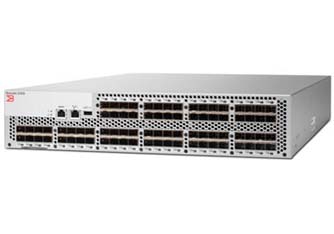Brocade 5300交換機是一款有80個端口、高密度的2U機架模塊,適用于中小型SAN整合、企業Fabric架構核心和邊緣。Brocade 5300可提供8 Gbps的性能,采用了冗余、可熱插拔組件而且支持平滑的軟件升級,可提高服務器和存儲設備利用率,同時降低虛擬化數據中心的復雜性。
1.概述
Brocade 5300 是一款8 Gbps光纖通道交換機,可提供卓越的性能和端口密度,適用于要求最為苛刻的SAN環境。Brocade 5300采用高效的2U機架設計,端口最多達80個,因此,如果要在整個企業對數據中心進行更大規模的整合和虛擬化,這款解決方案將是理想選擇。
適用于最苛刻環境的企業級交換機
Brocade 5300交換機采用了高效的2U機架設計,可配置48、64或80個端口,結合了1、2、4和8 Gbps技術。高端口密度、性能和“用多少,買多少”功能的結合能夠提高服務器和存儲資源利用率,同時降低虛擬數據中心的復雜性。
這一創新性設計使這款設備具備了非常高的功效、冷卻效率和機架密度,可幫助實現大中型服務器和存儲系統整合,可進一步節省成本,提高管理效率。Brocade 5300還采用了適應性網絡功能,能夠為關鍵任務數據中心應用提供最佳服務。
行業領先的性能和可擴展性
Brocade 5300采用了一種無阻塞架構,最多支持80個端口同時以8 Gbps(全雙工)的速率運行,并且不會出現超量使用現象——總帶寬高達640 Gbps。如此高的性能和連接簡便性使它成了不斷擴展的虛擬服務器環境中的理想選擇。另外,增強型ISL干線合并功能可以在單一邏輯鏈路上提供最高達64 Gbps的平衡數據吞吐量。
Brocade 5300具有較高的端口密度,因此,只需較少的交換機(不到傳統32或40端口邊緣交換機所需交換機設備的一半)便可支持數據中心光纖網絡核心部分的扇出。因此,它可以提供一個單域解決方案,既可簡化Fabric架構的管理,又可減少占用的數據中心空間。
Brocade 5300具有按需端口擴展(PoD)(端口可從48個擴展至64或80個)等多種功能,因此,企業可以根據需要隨時擴展存儲網絡而不會影響企業正常運營。
為了支持SAN擴展,Brocade 5300允許將服務器和存儲設備部署在相距600公里之外的地方,進而幫助企業實施最復雜的業務連續性和災難恢復計劃。
為利用Fibre Channel over Ethernet(FCoE)和數據中心橋接(DCB)整合服務器連接,Brocade 5300可兼容Brocade DCB/FCoE解決方案。
高級功能
Brocade 5300采用了最高用量者(Advanced Performance Monitoring的一個組成部分)和適應性網絡服務—一套包括入站速率控制、流量隔離和服務質量(QoS)功能的工具。這些先進的功能可幫助優化Fabric架構的運行,確保關鍵任務應用可獲得充足的帶寬。
為了實現最大的靈活性,Brocade 5300可提供集成路由功能來連接不同Fabric架構中的交換機。此外,它還包含了一種Virtual Fabric架構特性,可以將物理SAN分為多個邏輯Fabric架構。這樣就可以根據應用、業務部門、客戶或流量類型實現Fabric隔離而不會降低性能、可擴展性、安全性或可靠性。
簡化的部署和管理
博科交換機借助經濟高效的管理解決方案來優化存儲網絡資源,提高效率,同時降低擁有成本。EZSwitchSetup向導設計用于簡化部署。為保護操作培訓和管理投資,企業可以利用博科網絡顧問軟件(Brocade Network Advisor)管理Brocade 5300。博科網絡顧問軟件(Brocade Network Advisor)可通過可定制的控制面板和歷史數據可視性等特性降低運營成本和復雜性。此外,基于向導的配置、集成SAN診斷、策略監控、瓶頸檢測、FICON Port Decommissioning和Boot LUN分區等無縫的配置功能還可以提高業務靈活性。
BROCADE光收發模塊
Brocade 8Gbps交換機需要Brocade光收發模塊。這種模塊有多種型號,可以滿足不同的速度和距離要求。這些小型可熱插拔(SFP)模塊最適合用于Brocade 8 Gbps產品,可以最有效地提高性能,降低功耗,幫助確保關鍵任務應用的最高可用性。
行業標準遵從
Brocade產品符合行業標準,而且采用了普遍接受的工程實踐和流程。
2.特性
在單域、優化的2U機架中為最多80個端口提供8 Gbps的1:1性能
具有一流的端口密度和可擴展性的企業SAN交換機
借助1、2、4和8 Gbps自動偵測功能,保護現有設備投資
提供“邊增長邊付費”功能,利用按需端口擴展(PoD)功能將端口數量從48個擴展到64或80個
提供適應性網絡服務,如服務質量(QoS),幫助企業優化整合虛擬環境中的應用性能
將帶寬增長與功耗降低結合起來,提高能效
借助Brocade EZSwitchSetup安裝向導簡化安裝,并且可以與Microsoft Simple SAN兼容
包括Brocade Network Advisor Professional(博科網絡顧問軟件專業版),可實現全網絡架構范圍的監控和管理
提供光纖通道集成路由功能,支持選擇性設備共享,同時保持遠程Fabric架構隔離
3.規格
Systems Architecture
Fibre Channel ports
48-, 64-, and 80-port configurations (16-port increments via Ports on Demand licenses); universal (E, F, M, EX, FL) ports
Scalability
Full fabric architecture with 239 switches maximum
Certified maximum
Single Brocade FOS fabric: 56 domains, 19 hops
Single Brocade M-EOS fabric: 31 domains, 3 hops
Larger fabrics certified as required; consult Brocade or OEM SAN design documents for configuration details
Performance
1.063 Gbps line speed (full duplex); 2.125 Gbps line speed (full duplex); 4.25 Gbps line speed (full duplex); 8.5 Gbps line speed (full duplex); auto-sensing of 1, 2, 4, and 8 Gbps port speeds; optionally programmable to fixed port speed; speed matching between 1, 2, 4, and 8 Gbps ports
ISL Trunking
Frame-based trunking with up to eight 8 Gbps ports per ISL trunk with optional license; up to 64 Gbps per ISL trunk (8 ports × 8 Gbps [data rate])
Exchange-based load balancing across ISLs with DPS included in Fabric OS
Aggregate bandwidth
640 Gbps: 80 ports × 8 Gbps (data rate)
Fabric latency
Locally switched ports 700 ns, latency between port groups less than 2.1 μsec with no contention, cut-through routing at 8 Gbps between locally switched groups
Maximum frame size
2112-byte payload
Frame buffers
1460 dynamically allocated, 268 maximum per port
Classes of service
Class 2, Class 3, Class F (inter-switch frames)
Port types
FL_Port, F_Port, M_Port (Mirror Port), E_Port, EX_Port (Fibre Channel Integrated Routing); self discovery based on switch type (U_Port); optional port type control
Data traffic types
Fabric switches supporting unicast, multicast (255 groups), and broadcast
USB
1 USB port for firmware download, support save, and configuration upload/download
Media types
8 Gbps: Requires Brocade hot-pluggable SFP+, LC connector; 8 Gbps Short-Wavelength Laser (SWL); 8 Gbps Long-Wavelength Laser (LWL); distance depends on fiber-optic cable and port speed
4 Gbps: Requires Brocade hot-pluggable, Small Form-factor Pluggable (SFP), LC connector; 4 Gbps Short-Wavelength Laser (SWL); 4 Gbps Long-Wavelength Laser (LWL); 4 Gbps Extended Long-Wavelength Laser (ELWL); distance depends on fiber-optic cable and port speed
Fabric services
Advanced Performance Monitoring (including Top Talkers); Adaptive Networking (Ingress Rate Limiting, Traffic Isolation, QoS); BB credit recovery; Brocade Advanced Zoning (default zoning, port/WWN zoning, broadcast zoning); Dynamic Path Selection (DPS); Extended Fabrics; Fabric Watch; FDMI; Frame Redirection; FSPF; Integrated Routing; IPoFC; ISL Trunking; Management Server; N_Port Trunking; N_Port ID Virtualization (NPIV); NTP v3; Port Fencing; Registered State Change Notification (RSCN); Reliable Commit Service (RCS); Simple Name Server (SNS); Virtual Fabrics
FICON
FICON, FICON cascading (FOS and M-EOS), and FICON CUP
Options
Rack-mount rail kits (fixed, slide, mid-mount)
Management
Management
HTTP, SNMP v1/v3 (FE MIB, FC Management MIB), Telnet; Auditing, Change Management tracking, Syslog; Brocade Advanced Web Tools, Brocade Fabric Watch; EZSwitchSetup wizard, Brocade Data Center Fabric Manager (DCFM), Brocade Fabric Manager (optional, FOS environments only), Brocade EFCM 9.x (optional), command line interface; SMI-S compliant, SMI-S scripting toolkit; Administrative Domains; trial licenses for add-on capabilities
Security
DH-CHAP (between switches and end devices), HTTPS, IPsec, IP Filtering, LDAP, Port Binding, RADIUS, Role-Based Access Control (RBAC), Secure Copy (SCP), Secure RPC, SSH v2, SSL, Switch Binding, Trusted Switch
Management access
10/100 Ethernet (RJ-45), in-band over Fibre Channel; serial port (RJ-45); USB; call-home integration enabled through Brocade DCFM, EFCM, and Fabric Manager
Diagnostics
POST and embedded online/offline diagnostics, including RAStrace logging, environmental monitoring, non-disruptive daemon restart, FCping and Pathinfo (FC traceroute), port mirroring (SPAN port)
Mechanical
Enclosure
Non-port to port side airflow; 2U, 19-inch EIA-compliant, power from non-port side
Size
Width: 42.88 cm (16.88 in)
Height: 8.60 cm (3.40 in)
Depth: 61.05 cm (24.00 in)
System weight
15.6 kg (34.4 lb) with dual power supplies, without SFP/SFP+ media
Environment
Temperature
Operating: 0°C to 40°C (32°F to 104°F)
Non-operating and storage: -25°C to 70°C (-13°F to 158°F)
Humidity
Operating: 10% to 85% non-condensing
Non-operating and storage: 10% to 95% non-condensing
Altitude
Operating: Up to 3,000 meters (9,842 feet)
Non-operating and storage: Up to 12 kilometers (39,370 feet)
Shock
Operating: 20 g, 6 ms half-sine
Non-operating and storage: Half sine, 33 g 11 ms, 3/eg Axis
Vibration
Operating: 0.5 g sine, 0.4 grms random, 5 to 500 H z
Non-operating and storage: 2.0 g sine, 1.1 grms random, 5 to 500 H z
Heat dissipation
Maximum 80 ports: 939 BTU/hr
CO2 emissions
1012 kg per year (with 80 ports at 0.42 kg/kWh)
1.58 kg per Gbps per year
Airflow
Three hot-swappable, redundant fans
Maximum 60 CFM (cu. ft./min.); nominal 44 CFM
Power
Power Supply
Dual, hot-swappable redundant power supplies
Power inlet
C13
Input voltage
85 to 264 VAC nominal
Input line frequency
47 to 63 H z
Inrush current
Maximum of 38 amps for period between 10 to 150 ms at 50°C (122°F)
Power consumption
Nominal 260 watts; maximum 275 watts with 80 ports at 8 Gbps
